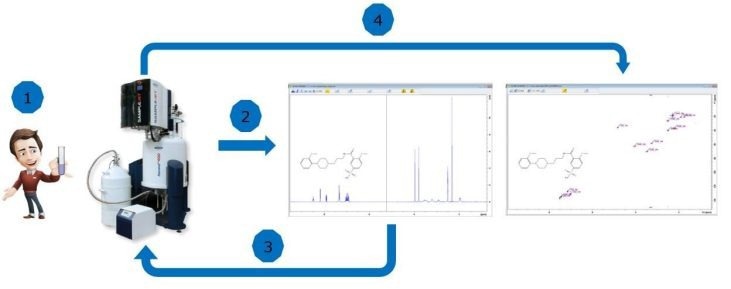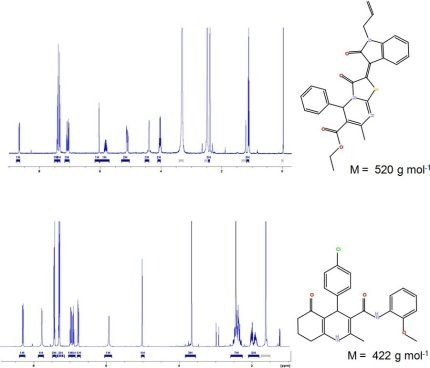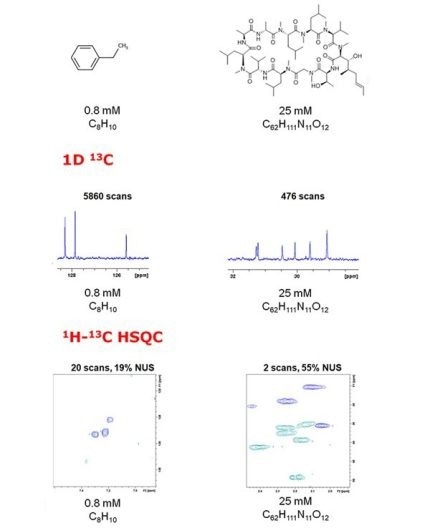Bruker's SmartDriveNMR helps to fully automate high-quality data collection.
Highlights
- Quality data: Developed in a fail-safe manner.
- Advanced acquisition: Both beginners and experts in NMR can benefit from full flexibility and automation.
- Small molecules: Obtain the best possible NMR results as quickly as possible.
SmartDriveNMR tutorial series
Collecting the right type of NMR data with the optimal parameters tailored for the problem at hand is crucial for any analytical investigation. Nevertheless, this procedure calls for NMR expertise and can be both labor- and time-intensive.
SmartDriveNMR is the ideal tool for any chemical researcher, as it provides easy-to-use software with maximum flexibility in defining complex research experiments.
Features
- 2Ds are carried out using Non-Uniform Sampling (NUS) in a fail-safe manner
- All major parameter sets are supported by SmartDriveNMR
- Automatic concentration determination and structure verification are possible
- SmartDriveNMR can be set as active or non-active for each individual sample
- SmartDriveNMR is fully integrated into IconNMR
Benefits
- Active decision-making making on-the-fly helps to save users time
- High-quality spectra is guaranteed
- SmartDriveNMR's highly flexible setup makes it an invaluable tool for both seasoned NMR practitioners and those new to the field
SmartDriveNMR workflow
- Through IconNMR, users can outline and submit their acquisition tasks, with the option to include structural details via a .mol file, although this is not a mandatory requirement.
- A quick 1D proton spectrum is collected and analyzed.
- Based on the analysis outcomes regarding the problem's complexity and signal strength, further experiments with optimal parameters might be needed.
- Follow-up experiments are scheduled and acquired in full automation if there is enough time. Reasoning triggering the acquisition is made available to the user. An automatic structure verification at the end of the run is an integrated part of SmartDriveNMR but is not mandatory.

Image Credit: Bruker BioSpin - NMR, EPR and Imaging
Applications
Fail-Safe Non-Uniform Sampling (NUS)
NUS is an acquisition method that can be used for nD NMR experiments. It involves skipping some increments in the indirect dimension(s) during acquisition and reconstructing the data afterward.
When applied properly, this reduces processing time without sacrificing data integrity. The ideal configurations are automated by SmartDriveNMR and rely on the sample being studied.
With the 1D Proton spectrum and the structure (if available) as the input (1), a conservative upper limit for the amount of sampling (NUS%) is estimated (2) e.g. 49%.
Now the acquisition of the 2D experiment is started with a significantly lower NUS% than the conservative estimate e.g. 15%.
The acquisition continues, increasing the NUS% step by step until the spectrum reaches a high quality and is free of artefacts without passing the conservative estimate (3).

Image Credit: Bruker BioSpin - NMR, EPR and Imaging
Active decision making
Making real-time decisions during the experiment can save time – for instance, solely based on the structure, an HSQC might have been required in both scenarios.
The top portion of the figure - SmartDriveNMR: Multiplets are easily assigned and well-separated.
- in mode OPTime: no HSQC will be acquired.
The bottom part of the figure - SmartDriveNMR: Multiplets overlap in the CH/CH2 region, HSQC will improve resolution.
- in mode OPTime: HSQC will be setup.

Image Credit: Bruker BioSpin - NMR, EPR and Imaging
Examine molecules of different sizes and concentrations
The software was tested with a wide range of NMR samples, each with a distinct concentration and molecular size, to demonstrate the versatility of SmartDriveNMR. A 400 MHz AVANCE NEO spectrometer fitted with a room temperature iProbe was used to perform the measurements. SmartDriveNMR operated within the MAXperiment mode.
For every sample that was used, SmartDriveNMR was able to obtain high-quality 1D 13C and 2D 1H-13C HSQC spectra in complete automation; however, the parameters required to do so varied significantly:
The number of scans for the carbon spectrum varied by more than ten times, ranging from 476 for the sample at a concentration of 25 mM to 5860 for the sample at 0.8 mM. The software only required ten scans to achieve a good spectrum quality for a third sample at an even higher concentration of 300 mM (spectrum not shown).
The HSQC experiments were set-up with 256 increments for the carbon dimension, but the portion of the measured datapoints using NUS ranged between 19% and 55%. A similar dynamic can also be seen for the number of scans – this ranged from 2 for the sample at 25 mM concentration to 20 at a concentration of 0.8 mM.

Image Credit: Bruker BioSpin - NMR, EPR and Imaging
Optimized 1D 13C acquisition
In this example, the number of scans for the 1D 13C experiment is conservatively estimated based on the results from the 1D 1H experiment, taking into consideration the design of the probe head (1). The number of scans was determined to be 1024.
After a certain number of scans—256 in this case—the signal-to-noise ratio (S/N) was calculated at acquisition time and compared to the target S/N specified by SmartDriveNMR (2).
The acquisition was then extended with more scans if the intended S/N had not yet been reached; the new S/N was then ascertained (3).
This process was iterated until the target S/N was obtained (4), at which point the acquisition was stopped (600 scans in this case).

Image Credit: Bruker BioSpin - NMR, EPR and Imaging
Specifications
Technical details
SmartDriveNMR is a fully integrated part of IconNMR. As such, it does necessitate an extra license.
The spectrometer administrator controls the activation of the system for each user group separately. Users have the discretion to choose whether to utilize SmartDriveNMR for each specific sample. The necessary inputs from the user include the selected operating mode and the maximum permissible time allocation per sample.
The various operating modes available are detailed in the subsequent table.
Source: Bruker BioSpin - NMR, EPR and Imaging
| Operation Mode |
Behaviour |
| FIXperiment |
Experiments are carried out exactly as they are set up by the user WITHOUT parameter optimization. The measurement time results directly from the set up experiments.
You get what you ordered. |
| OPTime |
Only the experiments highly beneficial for the given synthesis control task that fit in the given time are carried out with optimized parameters.
You get time-optimal spectrometer usage. |
| MAXperiment |
All experiments that are technically possible and fit into the given time will be carried out with optimized parameters.
You get the maximum possible number of experiments. |
To effectively illustrate the distinction between OPTime and MAXperiment modes, consider using an NMR sample that contains a high concentration of a straightforward, small molecule, such as ethanol.
In the OPTime mode, the acquisition concludes immediately following the initial scout experiment. On the other hand, in MAXperiment mode, the entire experiment portfolio is fully utilized:
Source: Bruker BioSpin - NMR, EPR and Imaging
| Settings |
Results |
| OPTime, 60 min |
1D 1H in < 3 min |
| MAXperiment, 60 min |
1D 1H, HSQC, 1D 13C, HMBC in ca. 50 min |